Paper Menu >>
Journal Menu >>
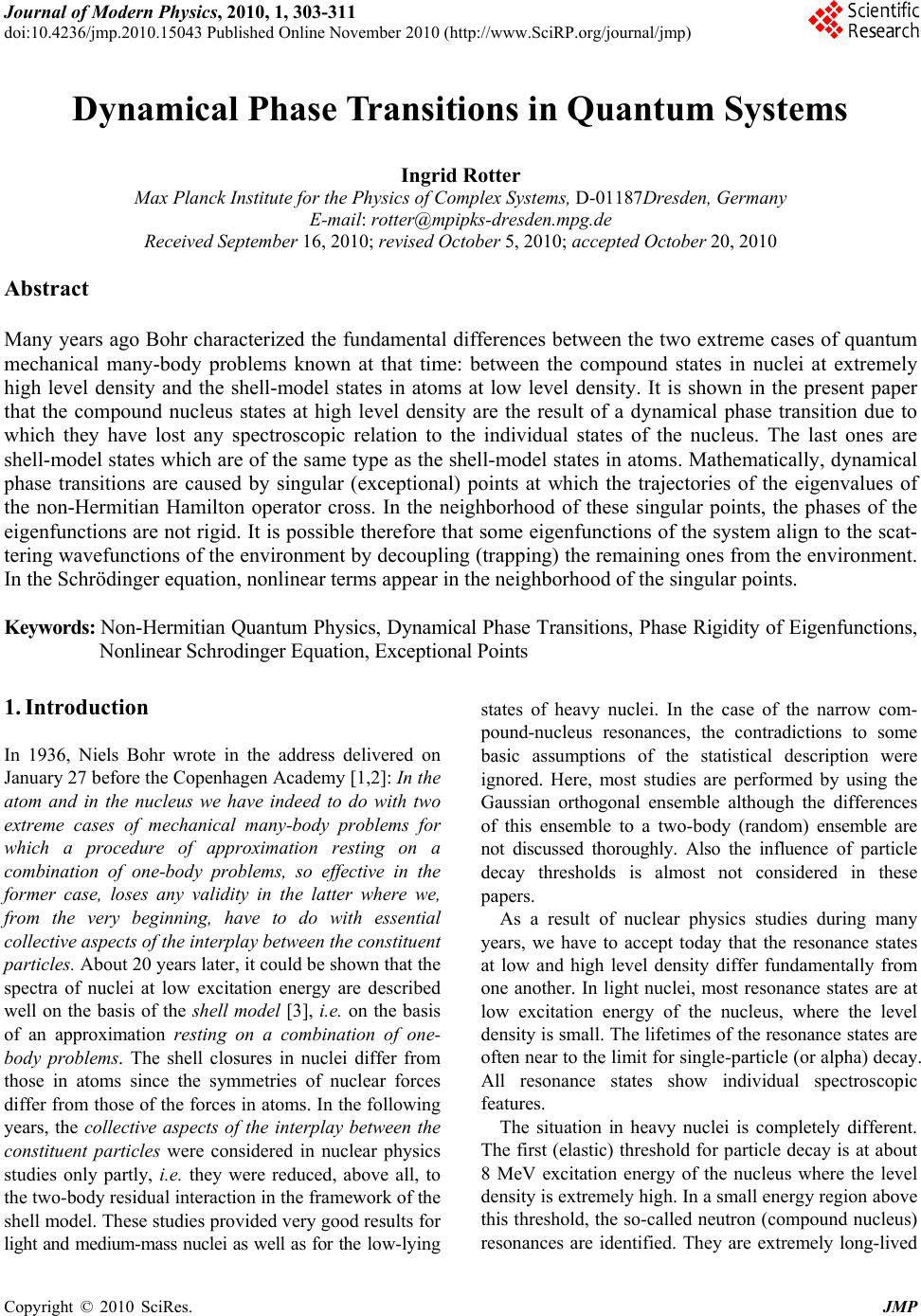 Journal of Modern Physics, 2010, 1, 303-311 doi:10.4236/jmp.2010.15043 Published Online November 2010 (http://www.SciRP.org/journal/jmp) Copyright © 2010 SciRes. JMP Dynamical Phase Transitions in Quantum Systems Ingrid Rotter Max Planck Institute for the Physics of Complex Systems, D-01187Dresden, Germany E-mail: rotter@mpipks-dresden.mpg.de Received September 16, 2010; revised October 5, 2010; accepted October 20, 2010 Abstract Many years ago Bohr characterized the fundamental differences between the two extreme cases of quantum mechanical many-body problems known at that time: between the compound states in nuclei at extremely high level density and the shell-model states in atoms at low level density. It is shown in the present paper that the compound nucleus states at high level density are the result of a dynamical phase transition due to which they have lost any spectroscopic relation to the individual states of the nucleus. The last ones are shell-model states which are of the same type as the shell-model states in atoms. Mathematically, dynamical phase transitions are caused by singular (exceptional) points at which the trajectories of the eigenvalues of the non-Hermitian Hamilton operator cross. In the neighborhood of these singular points, the phases of the eigenfunctions are not rigid. It is possible therefore that some eigenfunctions of the system align to the scat- tering wavefunctions of the environment by decoupling (trapping) the remaining ones from the environment. In the Schrödinger equation, nonlinear terms appear in the neighborhood of the singular points. Keywords: Non-Hermiti an Quantum Physics, Dynamical Phase Transitions, Phase Rigidity of Eigenfunctions, Nonlinear Schrodinger Equation, Exceptional Points 1. Introduction In 1936, Niels Bohr wrote in the address delivered on January 27 befor e th e Copenhag en Acad emy [1,2 ]: In the atom and in the nucleus we have indeed to do with two extreme cases of mechanical many-body problems for which a procedure of approximation resting on a combination of one-body problems, so effective in the former case, loses any validity in the latter where we, from the very beginning, have to do with essential collective aspects of the in terplay between the constituent particles. About 20 years later, it could be shown that the spectra of nuclei at low excitation energy are described well on the basis of the shell model [3], i.e. on the basis of an approximation resting on a combination of one- body problems. The shell closures in nuclei differ from those in atoms since the symmetries of nuclear forces differ fro m those of the forces in atoms. In the fo llowing years, the collective aspects of the interplay between the constituent particles were considered in nuclear physics studies only partly, i.e. they were reduced, above all, to the two-body residual interaction in the framework of the shell model. These studies prov ided very good results fo r light and medium-mass nuclei as well as for the lo w-lyi ng states of heavy nuclei. In the case of the narrow com- pound-nucleus resonances, the contradictions to some basic assumptions of the statistical description were ignored. Here, most studies are performed by using the Gaussian orthogonal ensemble although the differences of this ensemble to a two-body (random) ensemble are not discussed thoroughly. Also the influence of particle decay thresholds is almost not considered in these papers. As a result of nuclear physics studies during many years, we have to accept today that the resonance states at low and high level density differ fundamentally from one another. In light nuclei, most resonance states are at low excitation energy of the nucleus, where the level density is small. The lifetimes of the resonance states are often near to the limit for single-particle (or alpha) decay. All resonance states show individual spectroscopic features. The situation in heavy nuclei is completely different. The first (elastic) threshold for particle decay is at about 8 MeV excitation energy of the nucleus where the level density is extremely high. In a small energy region above this threshold, the so-called neutron (compound nucleus) resonances are identified. They are extremely long-lived 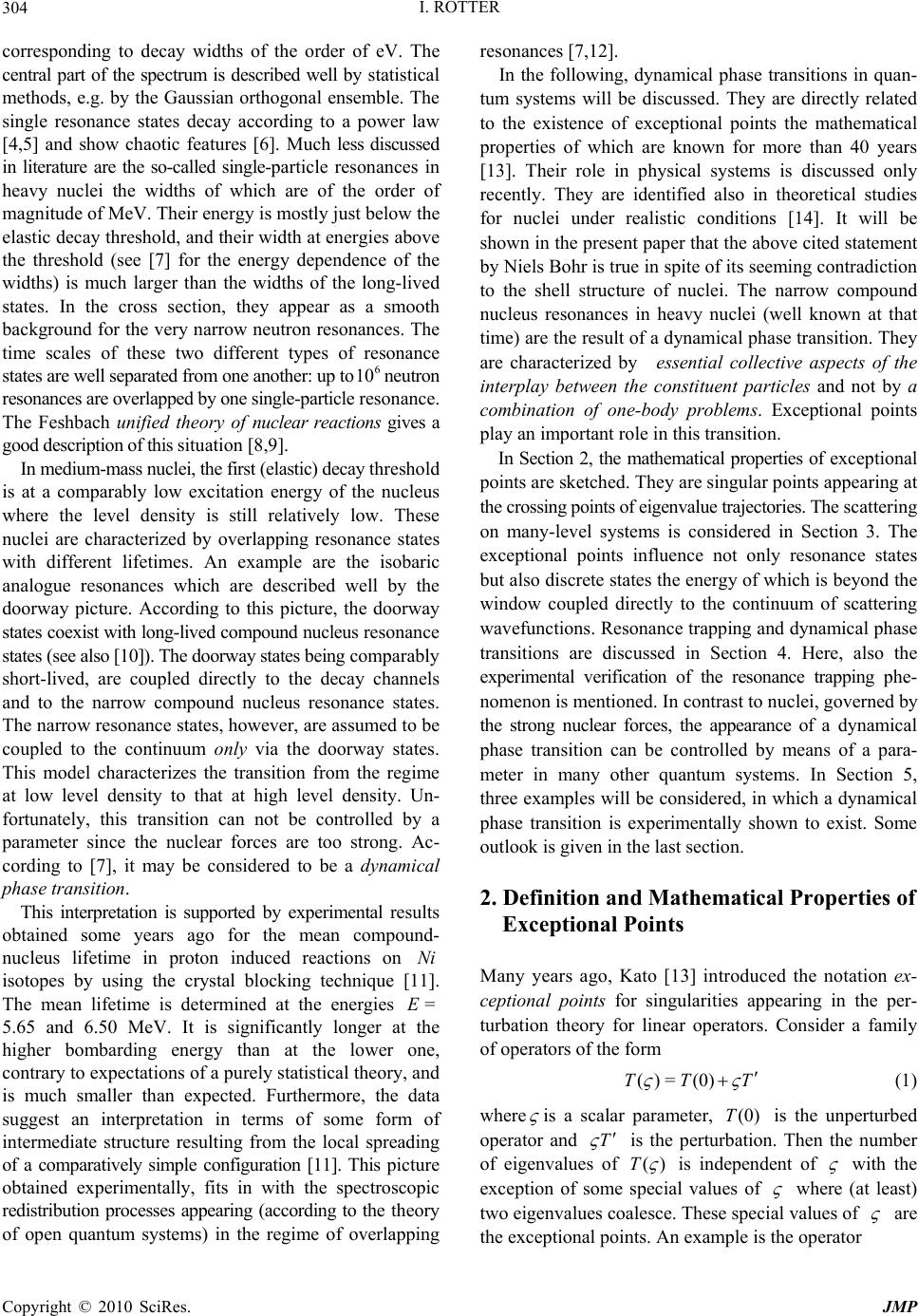 I. ROTTER Copyright © 2010 SciRes. JMP 304 corresponding to decay widths of the order of eV. The central part of the spectrum is described well by stat isti cal methods, e.g. by the Gaussian orthogonal ensemble. The single resonance states decay according to a power law [4,5] and show chaotic features [6]. Much less discussed in literature are the so-called single-particle resonances in heavy nuclei the widths of which are of the order of magnitude of MeV. Their energy is mostly just below the elastic decay threshold, and their width at energies above the threshold (see [7] for the energy dependence of the widths) is much larger than the widths of the long-lived states. In the cross section, they appear as a smooth background for the very narrow neutron resonances. The time scales of these two different types of resonance states are well separated from one another: up to6 10 neut ron resonances are overlapped by one single-particle resonance. The Feshbach unified theory of nuclear reactions gives a good description of this situation [8,9]. In medium-mass nuclei , t he firs t (el asti c ) dec ay threshold is at a comparably low excitation energy of the nucleus where the level density is still relatively low. These nuclei are characterized by overlapping resonance states with different lifetimes. An example are the isobaric analogue resonances which are described well by the doorway picture. According to this picture, the doorway states coexist with long-lived co mpound nucleus r e so n a n c e states (see also [10]). The doorway states being comparably short-lived, are coupled directly to the decay channels and to the narrow compound nucleus resonance states. The narrow resonance states, however, are assumed to be coupled to the continuum only via the doorway states. This model characterizes the transition from the regime at low level density to that at high level density. Un- fortunately, this transition can not be controlled by a parameter since the nuclear forces are too strong. Ac- cording to [7], it may be considered to be a dynamical phase transition. This interpretation is supported by experimental results obtained some years ago for the mean compound- nucleus lifetime in proton induced reactions on Ni isotopes by using the crystal blocking technique [11]. The mean lifetime is determined at the energies =E 5.65 and 6.50 MeV. It is significantly longer at the higher bombarding energy than at the lower one, contrary to expectations of a pu rely statistical th eo ry, and is much smaller than expected. Furthermore, the data suggest an interpretation in terms of some form of intermediate structure resulting from the local spreading of a comparatively simple configuration [11]. This picture obtained experimentally, fits in with the spectroscopic redistribution processes appearing (according to the theory of open quantum systems) in the regime of overlapping resonances [7,12] . In the following, dynamical phase transitions in quan- tum systems will be discussed. They are directly related to the existence of exceptional points the mathematical properties of which are known for more than 40 years [13]. Their role in physical systems is discussed only recently. They are identified also in theoretical studies for nuclei under realistic conditions [14]. It will be shown in the present paper that the above cited statement by Niels Bohr is true in spite of its seeming contradiction to the shell structure of nuclei. The narrow compound nucleus resonances in heavy nuclei (well known at that time) are the result of a dynamical phase transitio n. They are characterized by essential collective aspects of the interplay between the constituent particles and not by a combination of one-body problems. Exceptional points play an important role in this transition. In Section 2, the mathematical properties of ex cep tiona l points are sketched. They are singular points appearing at the crossing points of eigenvalue trajectories. The scattering on many-level systems is considered in Section 3. The exceptional points influence not only resonance states but also discrete states the energy of which is beyond the window coupled directly to the continuum of scattering wavefunctions. Resonance trapping and dynamical phase transitions are discussed in Section 4. Here, also the experimental verification of the resonance trapping phe- nomenon is mentioned. In contrast to nuclei, governed by the strong nuclear forces, the appearance of a dynamical phase transition can be controlled by means of a para- meter in many other quantum systems. In Section 5, three examples will be considered, in which a dynamical phase transition is experimentally shown to exist. Some outlook is given in the last section. 2. Definition and Mathematical Properties of Exceptional Points Many years ago, Kato [13] introduced the notation ex- ceptional points for singularities appearing in the per- turbation theory for linear operators. Consider a family of operators of the form ()= (0)TT T (1) where is a scalar parameter, (0)T is the unperturbed operator and T is the perturbation. Then the number of eigenvalues of ()T is independent of with the exception of some special values of where (at least) two eigenvalues coalesce. These special values of are the exceptional points. An example is the operator 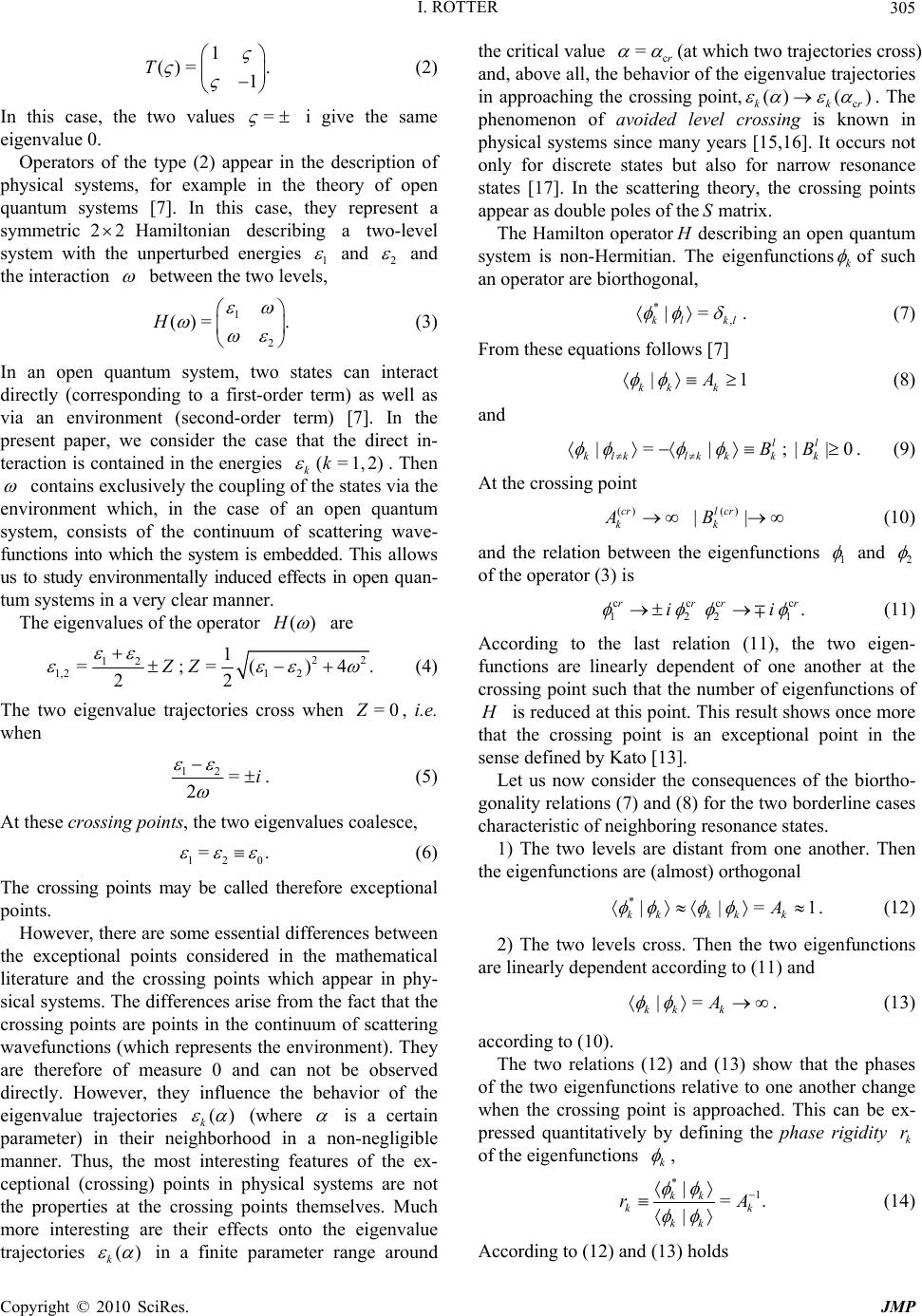 I. ROTTER Copyright © 2010 SciRes. JMP 305 1 ()= . 1 T (2) In this case, the two values = i give the same eigenvalue 0. Operators of the type (2) appear in the description of physical systems, for example in the theory of open quantum systems [7]. In this case, they represent a symmetric 22Hamiltonian describing a two-level system with the unperturbed energies 1 and 2 and the interaction between the two levels, 1 2 ()= .H (3) In an open quantum system, two states can interact directly (corresponding to a first-order term) as well as via an environment (second-order term) [7]. In the present paper, we consider the case that the direct in- teraction is contained in th e energies (=1,2) kk . Then contains exclusively the coupling of the states via the environment which, in the case of an open quantum system, consists of the continuum of scattering wave- functions into which the system is embedded. This allows us to study environmentally induced effects in open quan- tum systems in a very clear manner. The eigenvalues of the operator ()H are 22 12 1,21 2 1 =;=()4. 22 ZZ (4) The two eigenvalue trajectories cross when =0Z, i.e. when 12 =. 2i (5) At these crossing points, the two eigenvalues coalesce, 120 = . (6) The crossing points may be called therefore exceptional points. However, there are some essential differences between the exceptional points considered in the mathematical literature and the crossing points which appear in phy- sical systems. The differences arise from the fact that the crossing points are points in the continuum of scattering wavefunctions (which represents the environment). They are therefore of measure 0 and can not be observed directly. However, they influence the behavior of the eigenvalue trajectories () k (where is a certain parameter) in their neighborhood in a non-negligible manner. Thus, the most interesting features of the ex- ceptional (crossing) points in physical systems are not the properties at the crossing points themselves. Much more interesting are their effects onto the eigenvalue trajectories () k in a finite parameter range around the critical value c =r (at which two trajectories cross) and, above all, the behavior of the eigenvalue trajectories in approaching the crossing point,c ()( ) kkr . The phenomenon of avoided level crossing is known in physical systems since many years [15,16]. It occurs not only for discrete states but also for narrow resonance states [17]. In the scattering theory, the crossing points appear as double poles of theSmatrix. The Hamilton operator H describing an open qu antum system is non-Hermitian. The eigenfunctionsk of such an operator are biorthogonal, *, |= . kl kl (7) From these equations follows [7] |1 kk k A (8) and |=| ; ||0. ll klklkkk k BB (9) At the crossing point () () || crl cr kk AB (10) and the relation between the eigenfunctions 1 and 2 of the operator (3) is cccc 1221 . rrrr ii (11) According to the last relation (11), the two eigen- functions are linearly dependent of one another at the crossing point such that the number of eigenfunctions of H is redu ced at this point. This result shows on ce more that the crossing point is an exceptional point in the sense defined by Kato [1 3 ] . Let us now consider the consequences of the biortho- gonality relations (7) and (8) for the two borderlin e cases characteristic of neighboring resonance states. 1) The two levels are distant from one another. Then the eigenfunctions are (almost) orthogonal *||=1. kkkk k A (12) 2) The two levels cross. Then the two eigenfunctions are linearly dependent according to (11) and |= . kk k A (13) according to (10). The two relations (12) and (13) show that the phases of the two eigenfunctions relative to one another change when the crossing point is approached. This can be ex- pressed quantitatively by defining the phase rigidity k r of the eigenfunctions k , *1 |=. | kk kk kk rA (14) According to (12) and (13) hold s 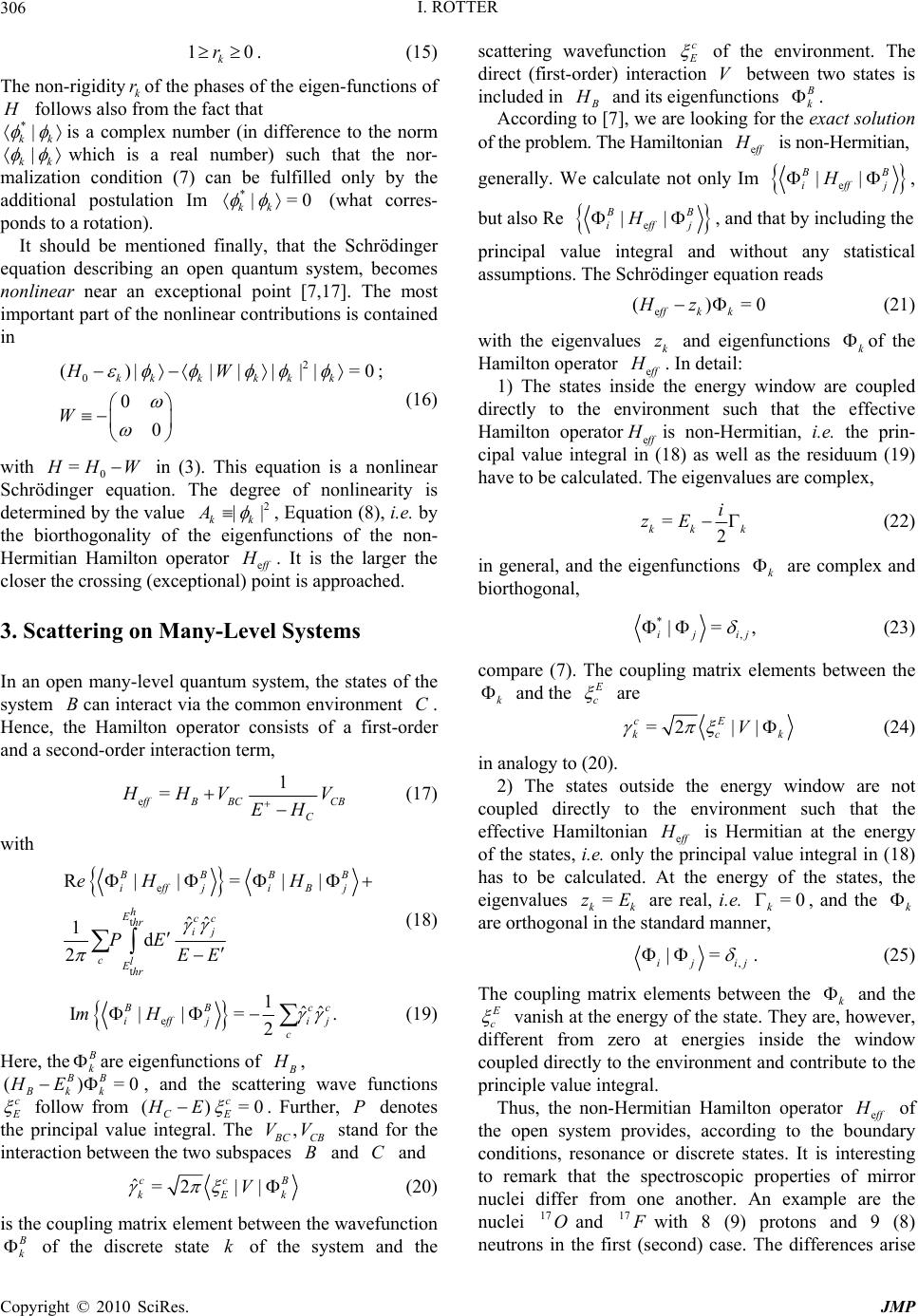 I. ROTTER Copyright © 2010 SciRes. JMP 306 1 0. k r (15) The non-rigidityk rof the phases of the eigen-functions of H follows also from the fact that *| kk is a complex number (in difference to the norm | kk which is a real number) such that the nor- malization condition (7) can be fulfilled only by the additional postulation Im *|=0 kk (what corres- ponds to a rotation). It should be mentioned finally, that the Schrödinger equation describing an open quantum system, becomes nonlinear near an exceptional point [7,17]. The most important part of the nonlinear contributions is contained in 2 0 () ||| || |=0; 0 0 kkkkk k HW W (16) with 0 = H HW in (3). This equation is a nonlinear Schrödinger equation. The degree of nonlinearity is determined by the value 2 || kk A , Equation (8), i.e. by the biorthogonality of the eigenfunctions of the non- Hermitian Hamilton operator e f f H . It is the larger the closer the crossing (exceptional) point is approached. 3. Scattering on Many-Level Systems In an open many-level quantum system, the states of the system Bcan interact via the common environment C. Hence, the Hamilton operator consists of a first-order and a second-order interaction term, e1 = f fBBC CB C H HV V EH (17) with e t t R||=|| ˆˆ 1d 2 BBBB iffj iBj h Ecc hr ij cl Ehr eH H PE EE (18) e1ˆˆ I||=. 2 B Bcc iffj ij c mH (19) Here, the B k are eigenfunctions of B H , ()=0 BB Bkk HE , and the scattering wave functions c E follow from () =0 c CE HE . Further, P denotes the principal value integral. The , B CCB VV stand for the interaction between the two subspaces B and C and ˆ=2 || ccB kEk V (20) is the coupling matrix element between the wavefunction B k of the discrete state k of the system and the scattering wavefunction c E of the environment. The direct (first-order) interaction V between two states is included in B H and its eigenfunctions B k . According to [7 ], we are lookin g for the exact solution of the problem. The Ham i ltonian e f f H is non-Hermitian, generally. We calculate not only Im e || BB iffj H, but also Re e || BB iffj H, and that by including the principal value integral and without any statistical assumptions. The Schrödinger equation reads e ()=0 ffk k Hz (21) with the eigenvalues k z and eigenfunctions k of the Hamilton operator e f f H . In detail: 1) The states inside the energy window are coupled directly to the environment such that the effective Hamilton operatore f f H is non-Hermitian, i.e. the prin- cipal value integral in (18) as well as the residuum (19) have to be calculated. The eigenvalues are complex, =2 kk k i zE (22) in general, and the eigenfunctions k are complex and biorthogonal, *, |=, ij ij (23) compare (7). The coupling matrix elements between the k and the E c are =2 || cE kck V (24) in analogy to (20). 2) The states outside the energy window are not coupled directly to the environment such that the effective Hamiltonian e f f H is Hermitian at the energy of the states, i.e. only the principal value integral in (18) has to be calculated. At the energy of the states, the eigenvalues = kk zE are real, i.e. =0 k , and the k are orthogonal in the standard manner, , |=. ij ij (25) The coupling matrix elements between the k and the E c vanish at the energy of the state. They are, however, different from zero at energies inside the window coupled directly to the environment and contribute to the principle value integral. Thus, the non-Hermitian Hamilton operator e f f H of the open system provides, according to the boundary conditions, resonance or discrete states. It is interesting to remark that the spectroscopic properties of mirror nuclei differ from one another. An example are the nuclei 17 Oand 17 F with 8 (9) protons and 9 (8) neutrons in the first (second) case. The differences arise 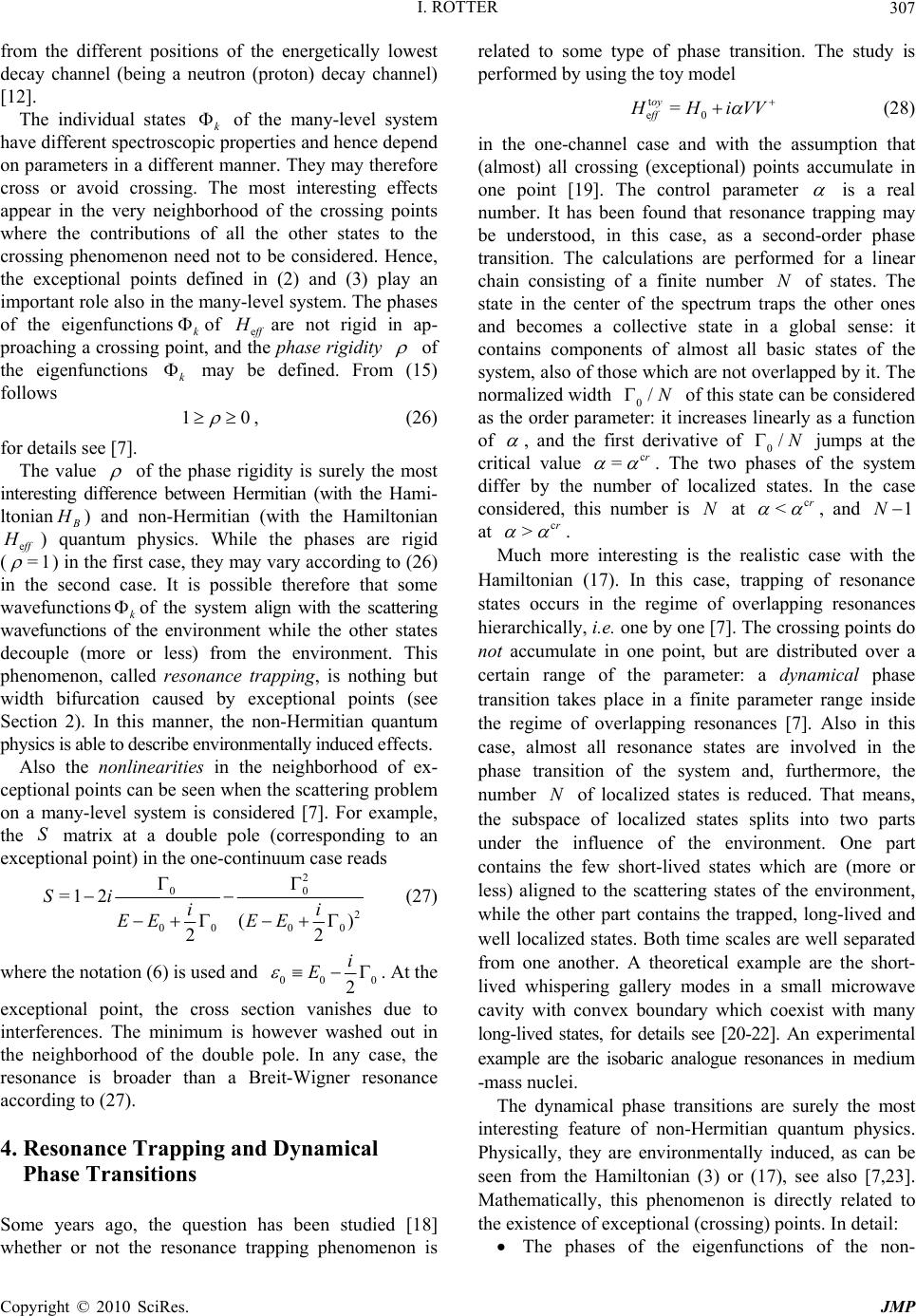 I. ROTTER Copyright © 2010 SciRes. JMP 307 from the different positions of the energetically lowest decay channel (being a neutron (proton) decay channel) [12]. The individual states k of the many-level system have different spectroscopic properties and hence depend on parameters in a different manner. They may therefore cross or avoid crossing. The most interesting effects appear in the very neighborhood of the crossing points where the contributions of all the other states to the crossing phenomenon need not to be considered. Hence, the exceptional points defined in (2) and (3) play an important role also in the many-level system. The phases of the eigenfunctionsk of e f f H are not rigid in ap- proaching a crossing point, and the phase rigidity of the eigenfunctions k may be defined. From (15) follows 10, (26) for details see [7]. The value of the phase rigidity is surely the most interesting difference between Hermitian (with the Hami- ltonian B H ) and non-Hermitian (with the Hamiltonian e f f H ) quantum physics. While the phases are rigid (=1 ) in the first case, they may vary according to (26) in the second case. It is possible therefore that some wavefunctionsk of the system align with the scattering wavefunctions of the environment while the other states decouple (more or less) from the environment. This phenomenon, called resonance trapping, is nothing but width bifurcation caused by exceptional points (see Section 2). In this manner, the non-Hermitian quantum physics is able to describe environmentally induced effects. Also the nonlinearities in the neighborhood of ex- ceptional points can be seen when the scattering problem on a many-level system is considered [7]. For example, the S matrix at a double pole (corresponding to an exceptional point) in the one-continuum case reads 2 00 2 00 00 =1 2() 22 Si ii EE EE (27) where the notation (6) is used and 00 0 2 i E . At the exceptional point, the cross section vanishes due to interferences. The minimum is however washed out in the neighborhood of the double pole. In any case, the resonance is broader than a Breit-Wigner resonance according to (27). 4. Resonance Trapping and Dynamical Phase Transitions Some years ago, the question has been studied [18] whether or not the resonance trapping phenomenon is related to some type of phase transition. The study is performed by using the toy model t e0 = oy ff H HiVV (28) in the one-channel case and with the assumption that (almost) all crossing (exceptional) points accumulate in one point [19]. The control parameter is a real number. It has been found that resonance trapping may be understood, in this case, as a second-order phase transition. The calculations are performed for a linear chain consisting of a finite number N of states. The state in the center of the spectrum traps the other ones and becomes a collective state in a global sense: it contains components of almost all basic states of the system, also of those which are not overlapped by it. The normalized width 0/N of this state can be considered as the order parameter: it increases linearly as a function of , and the first derivative of 0/N jumps at the critical value c =r . The two phases of the system differ by the number of localized states. In the case considered, this number is N at c <r , and 1N at c >r . Much more interesting is the realistic case with the Hamiltonian (17). In this case, trapping of resonance states occurs in the regime of overlapping resonances hierarchically, i.e. one by one [7]. The crossing points do not accumulate in one point, but are distributed over a certain range of the parameter: a dynamical phase transition takes place in a finite parameter range inside the regime of overlapping resonances [7]. Also in this case, almost all resonance states are involved in the phase transition of the system and, furthermore, the number N of localized states is reduced. That means, the subspace of localized states splits into two parts under the influence of the environment. One part contains the few short-lived states which are (more or less) aligned to the scattering states of the environment, while the other part contains the trapped, long-lived and well localized states. Both time scales are well separated from one another. A theoretical example are the short- lived whispering gallery modes in a small microwave cavity with convex boundary which coexist with many long-lived states, for details see [20-22]. An experimental example are the isobaric analogue resonances in medium -mass nuclei. The dynamical phase transitions are surely the most interesting feature of non-Hermitian quantum physics. Physically, they are environmentally induced, as can be seen from the Hamiltonian (3) or (17), see also [7,23]. Mathematically, this phenomenon is directly related to the existence of exceptional (crossing) points. In detail: The phases of the eigenfunctions of the non- 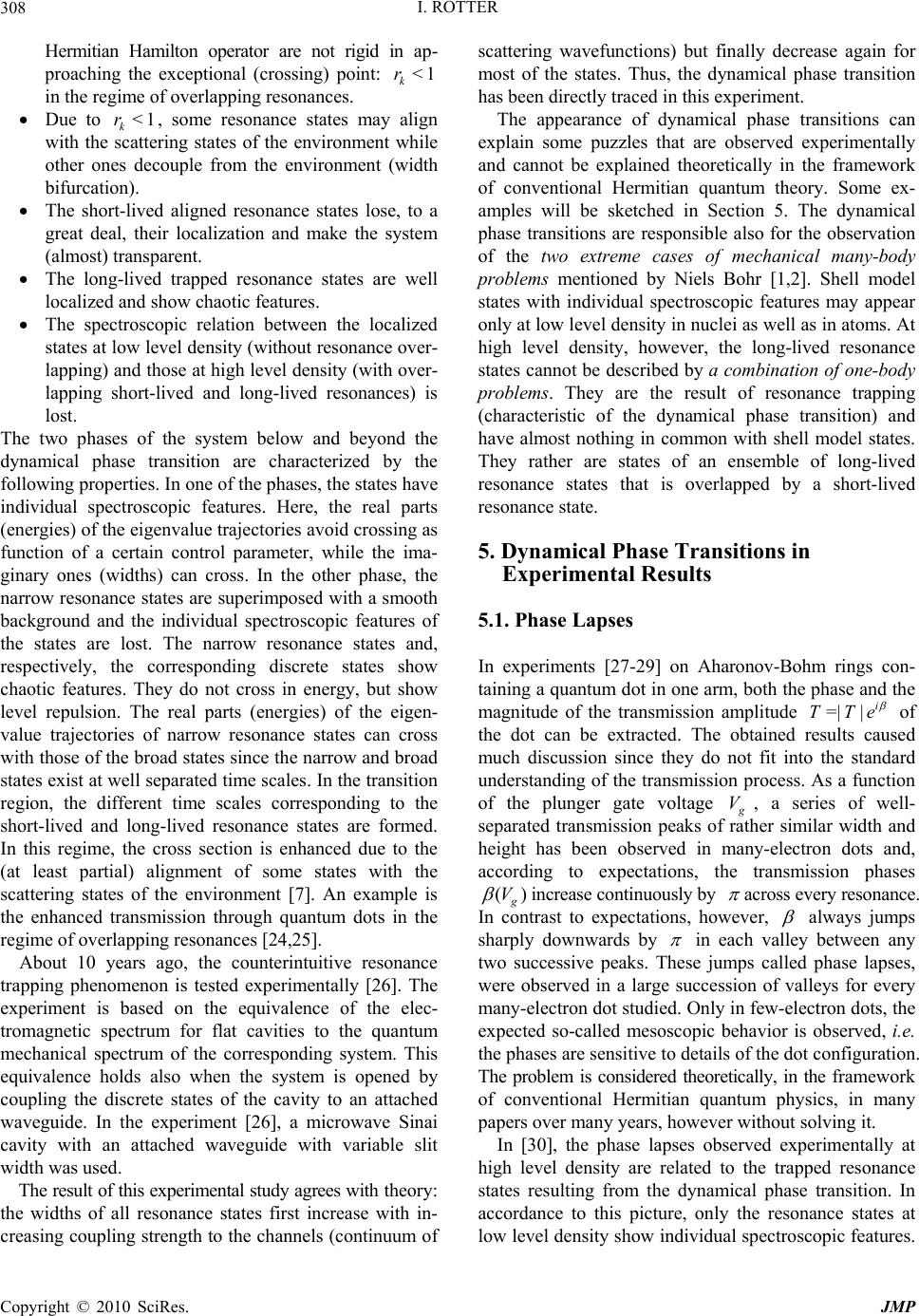 I. ROTTER Copyright © 2010 SciRes. JMP 308 Hermitian Hamilton operator are not rigid in ap- proaching the exceptional (crossing) point: <1 k r in the regime of overlappin g re sonances. Due to <1 k r, some resonance states may align with the scattering states of the environment while other ones decouple from the environment (width bifurcation). The short-lived aligned resonance states lose, to a great deal, their localization and make the system (almost) transparent. The long-lived trapped resonance states are well localized and show chaotic features. The spectroscopic relation between the localized states at low level density (without resonance over- lapping) and those at high level density (with over- lapping short-lived and long-lived resonances) is lost. The two phases of the system below and beyond the dynamical phase transition are characterized by the following properties. In one of the phases, the states have individual spectroscopic features. Here, the real parts (energies) of the eigenvalue trajectories avoid crossing as function of a certain control parameter, while the ima- ginary ones (widths) can cross. In the other phase, the narrow resonance states are superimposed with a smooth background and the individual spectroscopic features of the states are lost. The narrow resonance states and, respectively, the corresponding discrete states show chaotic features. They do not cross in energy, but show level repulsion. The real parts (energies) of the eigen- value trajectories of narrow resonance states can cross with those of the broad states since the narrow and broad states exist at well separated time scales. In the transition region, the different time scales corresponding to the short-lived and long-lived resonance states are formed. In this regime, the cross section is enhanced due to the (at least partial) alignment of some states with the scattering states of the environment [7]. An example is the enhanced transmission through quantum dots in the regime of ove r l apping resonances [2 4, 2 5]. About 10 years ago, the counterintuitive resonance trapping phenomenon is tested experimentally [26]. The experiment is based on the equivalence of the elec- tromagnetic spectrum for flat cavities to the quantum mechanical spectrum of the corresponding system. This equivalence holds also when the system is opened by coupling the discrete states of the cavity to an attached waveguide. In the experiment [26], a microwave Sinai cavity with an attached waveguide with variable slit width was used. The result of this experimental study agrees with th eo r y: the widths of all resonance states first increase with in- creasing coupling strength to the channels (continuum of scattering wavefunctions) but finally decrease again for most of the states. Thus, the dynamical phase transition has been directly traced in this experiment. The appearance of dynamical phase transitions can explain some puzzles that are observed experimentally and cannot be explained theoretically in the framework of conventional Hermitian quantum theory. Some ex- amples will be sketched in Section 5. The dynamical phase transitions are responsible also for the observation of the two extreme cases of mechanical many-body problems mentioned by Niels Bohr [1,2]. Shell model states with individual spectroscopic features may appear only at low level density in nuclei as well as in atoms. At high level density, however, the long-lived resonance states cannot be described by a combination of one-body problems. They are the result of resonance trapping (characteristic of the dynamical phase transition) and have almost nothing in common with shell model states. They rather are states of an ensemble of long-lived resonance states that is overlapped by a short-lived resonance state. 5. Dynamical Phase Transitions in Experimental Results 5.1. Phase Lapses In experiments [27-29] on Aharonov-Bohm rings con- taining a quantum dot in one arm, both the phase and the magnitude of the transmission amplitude =|| i TTe of the dot can be extracted. The obtained results caused much discussion since they do not fit into the standard understanding of the transmission process. As a function of the plunger gate voltage g V, a series of well- separated transmission peaks of rather similar width and height has been observed in many-electron dots and, according to expectations, the transmission phases () g V increase continuously by across every resonance. In contrast to expectations, however, always jumps sharply downwards by in each valley between any two successive peaks. These jumps called phase lapses, were observed in a large succession of valleys for every many-electron dot studied. Only in few-electron dots, the expected so-called mesoscopic behavior is observed, i.e. the phases are sensitive to details of the dot configuration. The problem is considered theoretically, in the framework of conventional Hermitian quantum physics, in many papers over many years, however without solving it. In [30], the phase lapses observed experimentally at high level density are related to the trapped resonance states resulting from the dynamical phase transition. In accordance to this picture, only the resonance states at low level density show individual spectroscopic features. 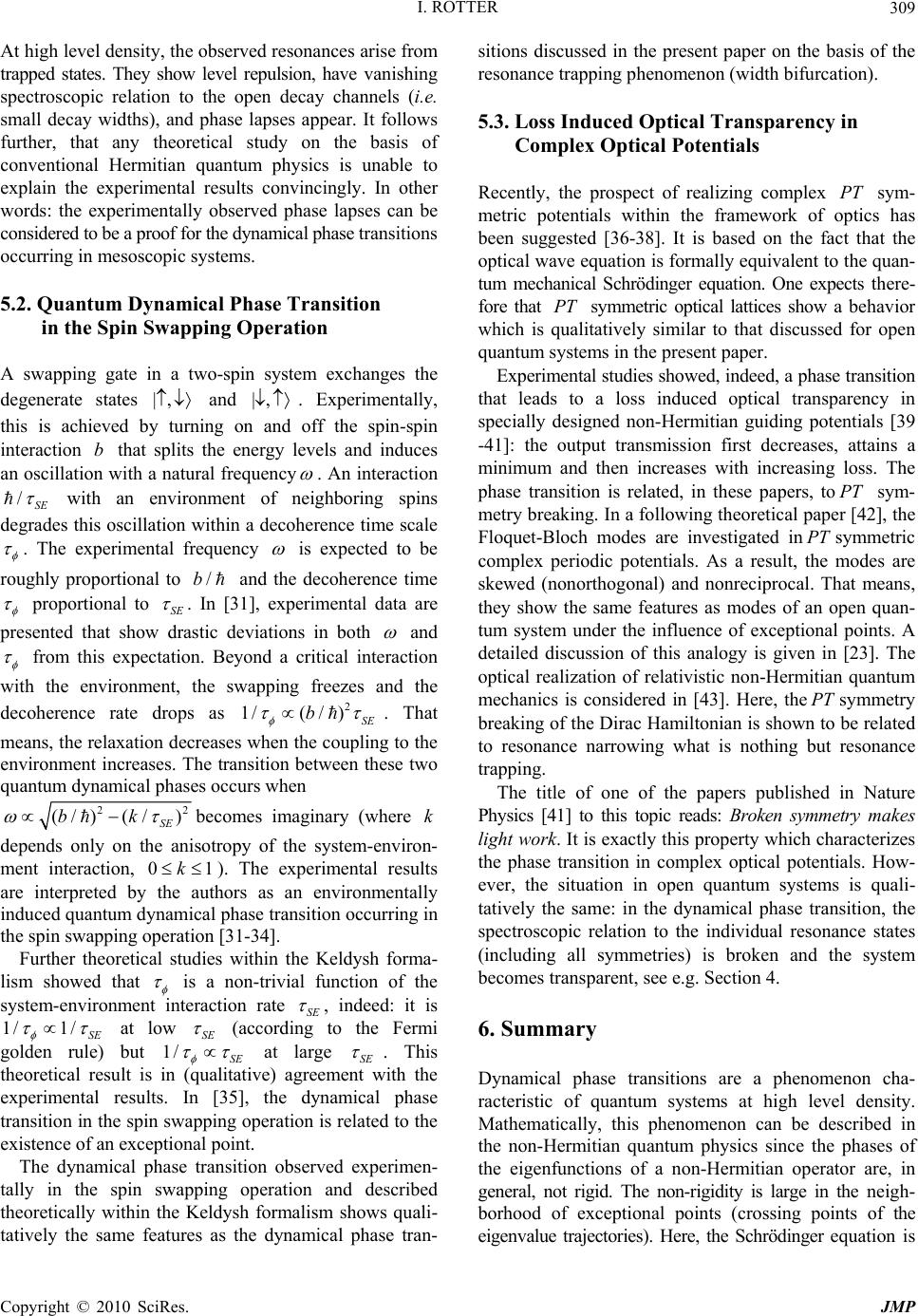 I. ROTTER Copyright © 2010 SciRes. JMP 309 At high level density, the observed resonances arise from trapped states. They show level repulsion, have vanishing spectroscopic relation to the open decay channels (i.e. small decay widths), and phase lapses appear. It follows further, that any theoretical study on the basis of conventional Hermitian quantum physics is unable to explain the experimental results convincingly. In other words: the experimentally observed phase lapses can be con sidere d to b e a pr oof for the dyn amical ph as e transitions occurring in mesoscopic systems. 5.2. Quantum Dynamical Phase Transition in the Spin Swapping Operation A swapping gate in a two-spin system exchanges the degenerate states |, and |,. Experimentally, this is achieved by turning on and off the spin-spin interaction b that splits the energy levels and induces an oscillation with a natural frequency . An interaction /SE with an environment of neighboring spins degrades this oscillation within a decoherence time scale . The experimental frequency is expected to be roughly proportional to /b and the decoherence time proportional to SE . In [31], experimental data are presented that show drastic deviations in both and from this expectation. Beyond a critical interaction with the environment, the swapping freezes and the decoherence rate drops as 2 1/( / )SE b . That means, the relaxation decreases when the coupling to the environment increases. The transition between these two quantum dynamical phases occurs when 22 (/) (/) SE bk becomes imaginary (where k depends only on the anisotropy of the system-environ- ment interaction, 01k). The experimental results are interpreted by the authors as an environmentally induced quantum dynamical phase transition occurring in the spin swapping operation [31-34]. Further theoretical studies within the Keldysh forma- lism showed that is a non-trivial function of the system-environment interaction rate SE , indeed: it is 1/1/SE at low SE (according to the Fermi golden rule) but 1/ SE at large SE . This theoretical result is in (qualitative) agreement with the experimental results. In [35], the dynamical phase transition in the spin swapping operation is related to the existence of an exceptional point. The dynamical phase transition observed experimen- tally in the spin swapping operation and described theoretically within the Keldysh formalism shows quali- tatively the same features as the dynamical phase tran- sitions discussed in the present paper on the basis of the resonance trapping phe n omenon (width bifurcation). 5.3. Loss Induced Optical Transparency in Complex Optical Potentials Recently, the prospect of realizing complex PT sym- metric potentials within the framework of optics has been suggested [36-38]. It is based on the fact that the optical wave equation is formally equivalent to the quan- tum mechanical Schrödinger equation. One expects there- fore that PT symmetric optical lattices show a behavior which is qualitatively similar to that discussed for open quantum systems in the present paper. Experimental studies showed, indeed, a phase transition that leads to a loss induced optical transparency in specially designed non-Hermitian guiding potentials [39 -41]: the output transmission first decreases, attains a minimum and then increases with increasing loss. The phase transition is related, in these papers, toPT sym- metry breaking. I n a following theoretical paper [42], the Floquet-Bloch modes are investigated inPTsymmetric complex periodic potentials. As a result, the modes are skewed (nonorthogonal) and nonreciprocal. That means, they show the same features as modes of an open quan- tum system under the influence of exceptional points. A detailed discussion of this analogy is given in [23]. The optical realization of relativistic non-Hermitian quantum mechanics is considered in [43]. Here, thePT symmetry breaking of the Dirac Hamiltonian is shown to be related to resonance narrowing what is nothing but resonance trapping. The title of one of the papers published in Nature Physics [41] to this topic reads: Broken symmetry makes light work. It is exactly this property which characterizes the phase transition in complex optical potentials. How- ever, the situation in open quantum systems is quali- tatively the same: in the dynamical phase transition, the spectroscopic relation to the individual resonance states (including all symmetries) is broken and the system becomes transparent, see e.g. Section 4. 6. Summary Dynamical phase transitions are a phenomenon cha- racteristic of quantum systems at high level density. Mathematically, this phenomenon can be described in the non-Hermitian quantum physics since the phases of the eigenfunctions of a non-Hermitian operator are, in general, not rigid. The non-rigidity is large in the neigh- borhood of exceptional points (crossing points of the eigenvalue trajectories). Here, the Schrödinger equation is 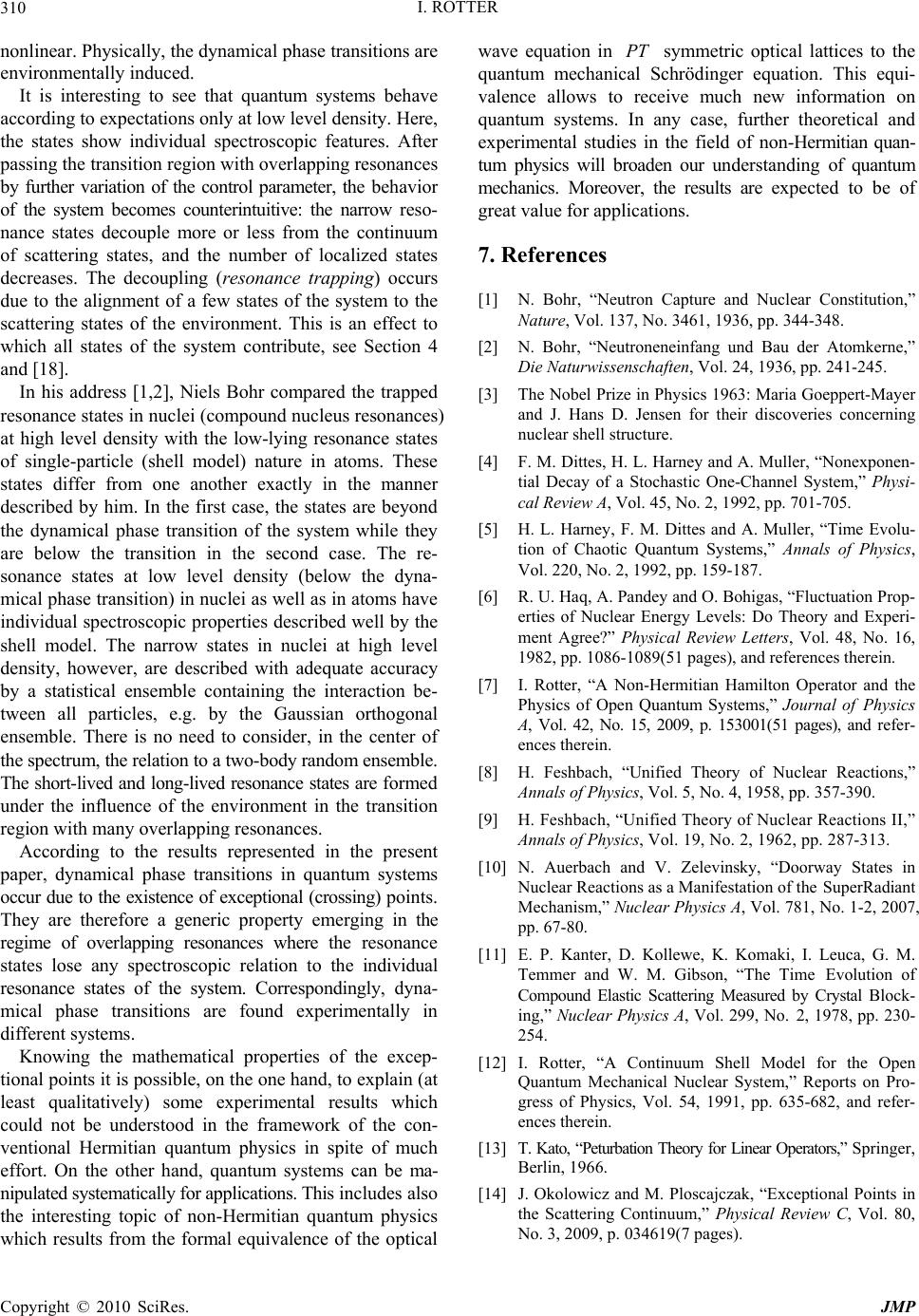 I. ROTTER Copyright © 2010 SciRes. JMP 310 nonlinear. Physically, the dynamical phase transitions are environmentally induced. It is interesting to see that quantum systems behave according to expectations only at low level density. Here, the states show individual spectroscopic features. After passing the transition region with overlapping resonances by further variation of the control parameter, the behavior of the system becomes counterintuitive: the narrow reso- nance states decouple more or less from the continuum of scattering states, and the number of localized states decreases. The decoupling (resonance trapping) occurs due to the alignment of a few states of the system to the scattering states of the environment. This is an effect to which all states of the system contribute, see Section 4 and [18]. In his address [1,2], Niels Bohr compared the trapped resonance states in nuclei (compound nucleus resonances) at high level density with the low-lying resonance states of single-particle (shell model) nature in atoms. These states differ from one another exactly in the manner described by him. In the first case, the states are beyond the dynamical phase transition of the system while they are below the transition in the second case. The re- sonance states at low level density (below the dyna- mical phase transition) in nuclei as well as in atoms have individual spectroscopic properties described well by the shell model. The narrow states in nuclei at high level density, however, are described with adequate accuracy by a statistical ensemble containing the interaction be- tween all particles, e.g. by the Gaussian orthogonal ensemble. There is no need to consider, in the center of the spectrum, the relation to a two-body random ensemble. The short-lived and long-lived resonance states are f ormed under the influence of the environment in the transition region with many overlapping resonances. According to the results represented in the present paper, dynamical phase transitions in quantum systems occur due to the existence of ex ceptional (crossing) p oi nt s. They are therefore a generic property emerging in the regime of overlapping resonances where the resonance states lose any spectroscopic relation to the individual resonance states of the system. Correspondingly, dyna- mical phase transitions are found experimentally in different systems. Knowing the mathematical properties of the excep- tional points it is possible, on the one hand, to explain (at least qualitatively) some experimental results which could not be understood in the framework of the con- ventional Hermitian quantum physics in spite of much effort. On the other hand, quantum systems can be ma- nipulated system atically for applications. This includes also the interesting topic of non-Hermitian quantum physics which results from the formal equivalence of the optical wave equation in PT symmetric optical lattices to the quantum mechanical Schrödinger equation. This equi- valence allows to receive much new information on quantum systems. In any case, further theoretical and experimental studies in the field of non-Hermitian quan- tum physics will broaden our understanding of quantum mechanics. Moreover, the results are expected to be of great value for applications. 7. References [1] N. Bohr, “Neutron Capture and Nuclear Constitution,” Nature, Vol. 137, No. 3461, 1936, pp. 344-348. [2] N. Bohr, “Neutroneneinfang und Bau der Atomkerne,” Die Naturwissenschaften, Vol. 24, 1936, pp. 241-245. [3] The Nobel Prize in Physics 1963: Maria Goeppert-Mayer and J. Hans D. Jensen for their discoveries concerning nuclear shell structure. [4] F. M. Dittes, H. L. Harney and A. Muller, “Nonexponen- tial Decay of a Stochastic One-Channel System,” Physi- cal Review A, Vol. 45, No. 2, 1992, pp. 701-705. [5] H. L. Harney, F. M. Dittes and A. Muller, “Time Evolu- tion of Chaotic Quantum Systems,” Annals of Physics, Vol. 220, No. 2, 1992, pp. 159-187. [6] R. U. Haq, A. Pandey and O. Bohigas, “Fluctuation Prop- erties of Nuclear Energy Levels: Do Theory and Experi- ment Agree?” Physical Review Letters, Vol. 48, No. 16, 1982, pp. 1086-1089(51 pages), and references therein. [7] I. Rotter, “A Non-Hermitian Hamilton Operator and the Physics of Open Quantum Systems,” Journal of Physics A, Vol. 42, No. 15, 2009, p. 153001(51 pages), and refer- ences therein. [8] H. Feshbach, “Unified Theory of Nuclear Reactions,” Annals of Physics, Vol. 5, No. 4, 1958, pp. 357-390. [9] H. Feshbach, “Unified Theory of Nuclear Reactions II,” Annals of Physics, Vol. 19, No. 2, 1962, pp. 287-313. [10] N. Auerbach and V. Zelevinsky, “Doorway States in Nuclear Reactions as a Manifestation of the SuperRadiant Mechanism,” Nuclear Physics A, Vol. 781, No. 1-2, 2007, pp. 67-80. [11] E. P. Kanter, D. Kollewe, K. Komaki, I. Leuca, G. M. Temmer and W. M. Gibson, “The Time Evolution of Compound Elastic Scattering Measured by Crystal Block- ing,” Nuclear Physics A, Vol. 299, No. 2, 1978, pp. 230- 254. [12] I. Rotter, “A Continuum Shell Model for the Open Quantum Mechanical Nuclear System,” Reports on Pro- gress of Physics, Vol. 54, 1991, pp. 635-682, and refer- ences therein. [13] T. Kato, “Peturbation Theory for Linear Operators,” S p r in g e r , Berlin, 1966. [14] J. Okolowicz and M. Ploscajczak, “Exceptional Points in the Scattering Continuum,” Physical Review C, Vol. 80, No. 3, 2009, p. 034619(7 pages). 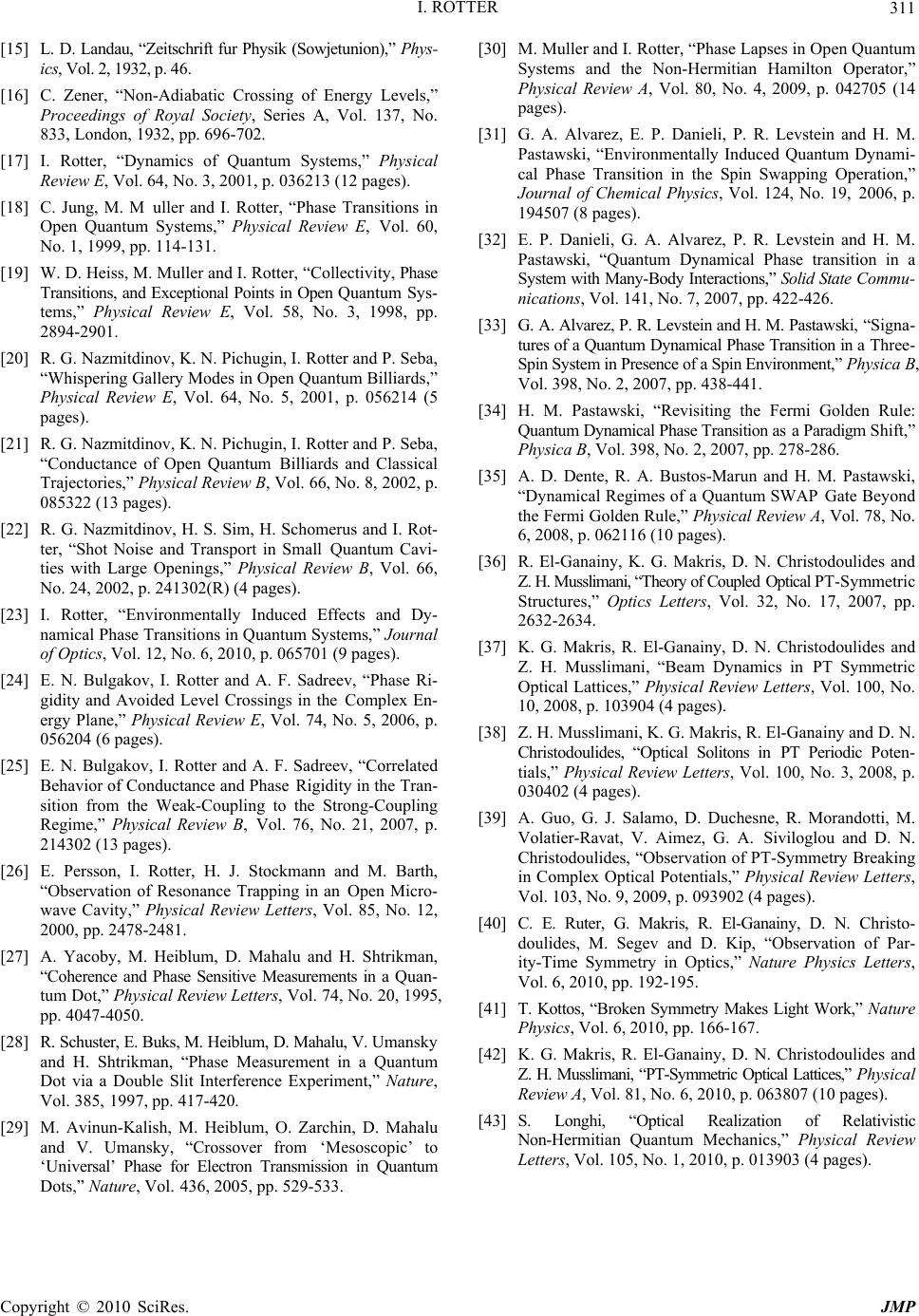 I. ROTTER Copyright © 2010 SciRes. JMP 311 [15] L. D. Landau, “Zeitschrift fur Physik (Sowjetunion),” Phys- ics, Vol. 2, 19 32, p. 46. [16] C. Zener, “Non-Adiabatic Crossing of Energy Levels,” Proceedings of Royal Society, Series A, Vol. 137, No. 833, London, 1932, pp. 696-702. [17] I. Rotter, “Dynamics of Quantum Systems,” Physical Review E, Vol. 64, No. 3, 2001, p. 036213 (12 pages). [18] C. Jung, M. Muller and I. Rotter, “Phase Transitions in Open Quantum Systems,” Physical Review E, Vol. 60, No. 1, 1999, pp. 114-131. [19] W. D. Heiss, M. Muller and I. Rotter, “Collectivity, Phase Transi tions, and Except ional Points in Open Qu an tum Sy s- tems,” Physical Review E, Vol. 58, No. 3, 1998, pp. 2894-2901. [20] R. G. Nazmitdinov, K. N. Pichugin, I. Rotter and P. Seba, “Whispering Gallery Modes in Open Quantum Billiards,” Physical Review E, Vol. 64, No. 5, 2001, p. 056214 (5 pages). [21] R. G. Nazmitdinov, K. N. Pichugin, I. Rotter and P. Seba, “Conductance of Open Quantum Billiards and Classical Trajectories,” Physical Review B, Vol. 66, No. 8, 2002, p. 085322 (13 pages). [22] R. G. Nazmitdinov, H. S. Sim, H. Schomerus and I. Rot- ter, “Shot Noise and Transport in Small Quantum Cavi- ties with Large Openings,” Physical Review B, Vol. 66, No. 24, 2002, p. 241302(R) (4 pages). [23] I. Rotter, “Environmentally Induced Effects and Dy- namical Phase Transitions in Quantum Systems,” Journal of Optics, Vol. 12, No. 6, 2010, p. 065701 (9 pages). [24] E. N. Bulgakov, I. Rotter and A. F. Sadreev, “Phase Ri- gidity and Avoided Level Crossings in the Complex En- ergy Plane,” Physical Review E, Vol. 74, No. 5, 2006, p. 056204 (6 pages). [25] E. N. Bulgakov, I. Rotter and A. F. Sadreev, “Correlated Behavior of Conductance and Phase Rigidity in the Tran- sition from the Weak-Coupling to the Strong-Coupling Regime,” Physical Review B, Vol. 76, No. 21, 2007, p. 214302 (13 pages). [26] E. Persson, I. Rotter, H. J. Stockmann and M. Barth, “Observation of Resonance Trapping in an Open Micro- wave Cavity,” Physical Review Letters, Vol. 85, No. 12, 2000, pp. 2478-2481. [27] A. Yacoby, M. Heiblum, D. Mahalu and H. Shtrikman, “Coherence and Phase Sensitive Measurements in a Quan- tum Dot,” Physical Review Letters, Vol. 74, No. 20, 1995, pp. 4047-4050. [28] R. Schuster, E. Buks, M. Heiblum, D. Mahal u, V. U m a ns ky and H. Shtrikman, “Phase Measurement in a Quantum Dot via a Double Slit Interference Experiment,” Nature, Vol. 385, 1997, pp. 417-420. [29] M. Avinun-Kalish, M. Heiblum, O. Zarchin, D. Mahalu and V. Umansky, “Crossover from ‘Mesoscopic’ to ‘Universal’ Phase for Electron Transmission in Quantum Dots,” Nature, Vol. 436, 2005, pp. 529-533. [30] M. Muller and I. Rotter, “Phase Lapses in Open Quantum Systems and the Non-Hermitian Hamilton Operator,” Physical Review A, Vol. 80, No. 4, 2009, p. 042705 (14 pages). [31] G. A. Alvarez, E. P. Danieli, P. R. Levstein and H. M. Pastawski, “Environmentally Induced Quantum Dynami- cal Phase Transition in the Spin Swapping Operation,” Journal of Chemical Physics, Vol. 124, No. 19, 2006, p. 194507 (8 pages). [32] E. P. Danieli, G. A. Alvarez, P. R. Levstein and H. M. Pastawski, “Quantum Dynamical Phase transition in a System with Many-Body Interactions,” Solid State C o mm u - nications, Vol. 141, No. 7, 2007, pp. 422-426. [33] G. A. Alvarez, P. R. Levstein and H. M. Pastawski, “Signa- tures of a Quant um Dynamical Phase Transition in a T h r ee - Spin System in Presence of a Spi n Env ir onm en t, ” Physica B, Vol. 398, No. 2, 2007, pp. 438-441. [34] H. M. Pastawski, “Revisiting the Fermi Golden Rule: Quantum Dynamical Phase Transition as a Paradigm Shift,” Physica B, Vol. 398, No. 2, 2007, pp. 278-286. [35] A. D. Dente, R. A. Bustos-Marun and H. M. Pastawski, “Dynamical Regimes of a Quantum SWAP Gate Beyond the Fermi Golden Rule,” Physical Review A, Vol. 78, No. 6, 2008, p. 062116 (10 pages). [36] R. El-Ganainy, K. G. Makris, D. N. Christodoulides and Z. H. Musslimani, “Theory of Coupled Opt ic al PT -Symm etric Structures,” Optics Letters, Vol. 32, No. 17, 2007, pp. 2632-2634. [37] K. G. Makris, R. El-Ganainy, D. N. Christodoulides and Z. H. Musslimani, “Beam Dynamics in PT Symmetric Optical Lattices,” Physical Review Letters, Vol. 100, No. 10, 2008, p. 103904 (4 pages). [38] Z. H. Musslimani, K. G. Makris, R. El-Ganainy and D. N. Christodoulides, “Optical Solitons in PT Periodic Poten- tials,” Physical Review Letters, Vol. 100, No. 3, 2008, p. 030402 (4 pages). [39] A. Guo, G. J. Salamo, D. Duchesne, R. Morandotti, M. Volatier-Ravat, V. Aimez, G. A. Siviloglou and D. N. Christodoulides, “Observation of PT-Symmetry Breaking in Complex Optical Potentials,” Physical Review Letters, Vol. 103, No. 9, 2009, p. 093902 (4 pages). [40] C. E. Ruter, G. Makris, R. El-Ganainy, D. N. Christo- doulides, M. Segev and D. Kip, “Observation of Par- ity-Time Symmetry in Optics,” Nature Physics Letters, Vol. 6, 2010, pp. 192-195. [41] T. Kottos, “Broken Symmetry Makes Light Work,” Nature Physics, Vol. 6, 2010, pp. 166-167. [42] K. G. Makris, R. El-Ganainy, D. N. Christodoulides and Z. H. Musslimani, “PT-Symmetric Optical Lattices,” Physical Review A, Vol. 81, No. 6, 2010, p. 063807 (10 pages). [43] S. Longhi, “Optical Realization of Relativistic Non-Hermitian Quantum Mechanics,” Physical Review Letters, Vol. 105, No. 1, 2010, p. 013903 (4 pages). |

